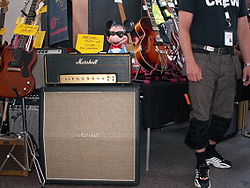- Marshall 1959
-
The Marshall Super Lead Model 1959 is a guitar amplifier head made by Marshall. One of the famous Marshall Plexis, it was introduced in 1965 and with its associated 4x12" cabinets gave rise to the "Marshall stack."
Contents
History
The 1959 (Marshall's identifying numbers are not years of manufacture), first produced in 1965 and made until 1981 (when it was replaced by the JCM-800[1]), is an amplifier in Marshall's "Standard" series.[2] One of its raisons d'etre was a request by Pete Townshend, who asked Marshall to make a 100 watt amplifier; Ken Bran and Dudley Craven of Marshall's development team complied.[3] Its output was first channeled into an 8x12" cabinet, but that single, unwieldy cabinet was quickly changed to a set of 4x12" cabinets, creating the "Marshall stack."[4][5] The amplifier also came as a PA and a bass version.[1]
The Plexiglas panel led to the name "Plexi," and, while 50-watt models of the time are also called Plexis,[6] the 1959 100 watt model is often referred to as the "original" Plexi.[7]
In 1969, Marshall replaced the Plexiglass panel with one of gold aluminum.[1] There were other modifications: the KT66 tubes were replaced with EL34. After 1976, the plate voltages were lowered slightly for improved reliability. But during the 1970s, Marshall's increasing exports overseas led to a problem: often the EL34 tubes would break during transportation, to the point where amps began being shipped from the factory with more rugged 6550 tubes, which are "stiffer and not as harmonically rich" as the EL 34 tubes.[3]
Reissues
The amplifier was reissued for the first time in 1988 (the 1959S), and again from 1991 to 1993 (the 1959X) and from 1993 to 1995 (the 1959 SLP).[1] In 2005, Marshall introduced the 1959 HW (for "hand-wired"), based on the 1967-1969 models, with negative feedback added corresponding to the 1969 model.[8] This amplifier was called "expensive but good."[9] Guitar Player magazine called the 1959 "monumentally huge, frightfully loud, and painfully expensive," and it its review of the 1959HW said it was "quick, percussive, articulate," and required a "total commitment to volume."[10]
Technical specifications
The 1959 had 100 watts of power, two channels, and four inputs. They were equipped with four KT66 tubes, but models made after 1969 had four EL34 tubes; it had three ECC83 tubes in the pre-amplification stage. A model with tremolo, the 1959T, was available until 1973.[1]
The amplifier had four inputs into two channels. The lead channel has a boosted bright tone, and the rhythm channel has a flat response. Each channel has a high and a low gain input; the low gain input is attenuated by 6dB.[2] The channels can be linked with a jumper cable.[11]
Notable early users
Slash from the band Guns N' Roses used this amp to record GNR's most famous abum, Appetite For Destruction. Besides Pete Townsend of The Who, early users include Eric Clapton, who in 1966, when he founded Cream, traded in his famous Bluesbreaker combo for a 1959 Plexi,[12][13] and Jimi Hendrix, who used a 1959 with four 4x12" cabinets (his "couple of great refrigerators") at the 1969 Woodstock Festival[9] and established the Marshall as the "definitive rock amp."[14] Eddie Van Halen was another famous user of the Marshall Plexi, using them from the mid 70's until the OU812 album in 1988.
Other notable users
References
- ^ a b c d e Blue Book of Guitar Amplifiers, Zachary R. (2008). Blue Book of Guitar Amplifiers. 3. Alfred Music. pp. 335–36. ISBN 9781886768598. http://books.google.com/books?id=pKCYz1WfZCQC&pg=PA335.
- ^ a b Boehnlein, John (1998). The High Performance Marshall Handbook: A Guide to Great Marshall Amplifier Sounds. Bold Strummer. pp. 3–5. ISBN 9780933224803. http://books.google.com/books?id=vm00dXNS30IC&pg=PA3.
- ^ a b Pittmann, Aspen (2003). The Tube Amp Book. Hal Leonard. pp. 72–74. ISBN 9780879307677. http://books.google.com/books?id=JT1I7Ld76YsC&pg=PA72.
- ^ Millard, A.J. (2004). The electric guitar: a history of an American icon. JHU Press. pp. 155. ISBN 9780801878626. http://books.google.com/books?id=zUlt7Q71_ssC&pg=PA155.
- ^ Doyle, Michael (1993). The history of Marshall: the illustrated story of "the sound of rock". Hal Leonard. pp. 37. ISBN 1993. http://books.google.com/books?id=E90tMBs9_FEC&pg=PA37.
- ^ Molenda, Michael (June 2008). "The Homogenization of Rock Guitar Tone". Guitar Player 42 (6): 76–78.
- ^ Guppy, Nick (3 November 2008). "Bad Cat BC 50". MusicRadar. http://www.musicradar.com/gear/all/amplification/instrument-amps/guitar-amp-heads/bc-50-head-179578/review. Retrieved 16 April 2010.
- ^ "Marshall 1959HW Owner's Manual". Marshall Amplification. pp. 1, 3. http://www.marshallamps.com/downloads/files/1959HW%20hbk.pdf. Retrieved 16 April 2010.
- ^ a b Balmer, Paul; Hank Marvin (2007). The Fender Stratocaster Handbook: How to Buy, Maintain, Set Up, Troubleshoot, and Modify Your Strat. MBI. pp. 156–57. ISBN 9780760329832. http://books.google.com/books?id=EiySv-2E8tUC&pg=PA156.
- ^ Buddingh, Terry (December 2005). "Marshall 1959HW Super Lead 100". Guitar Player 39 (12): 176–78.
- ^ "Marshall 1959HW Owner's Manual". Marshall Amplification. pp. 6. http://www.marshallamps.com/downloads/files/1959HW%20hbk.pdf. Retrieved 16 April 2010.
- ^ Gulla, Bob (2008). Guitar Gods: The 25 Players Who Made Rock History. ABC-CLIO. pp. 46. ISBN 9780313358067. http://books.google.com/books?id=DL3I9qQWdeAC&pg=PA46.
- ^ Hunter, Dave (Hal Leonard). Guitar rigs: classic guitar & amp combinations. 2005. pp. 113. http://books.google.com/books?id=p1-kULtG9tgC&pg=PT113.
- ^ Trynka, Paul (1996). Rock Hardware. Hal Leonard. pp. 19. ISBN 9780879304287. http://books.google.com/books?id=HDrIjd5FQ8QC&pg=RA19.
- ^ Prown, Pete; Lisa Sharken (2003). Gear Secrets of the Guitar Legends: How to Sound Like Your Favorite Players. Hal Leonard. p. 2. ISBN 9780879307516. http://books.google.com/books?id=vqQjuzPrqIwC&pg=PA2.
Marshall Amplification By name By model number Model 1959 · Model 1961 · Model 1962 · Model 1963 · Model 1966 · Model 1967 · Model 1978 · Model 1985 · Model 1986 · Model 1987 · Model 1989 · Model 2203 · Model 2204 · Model 2210Categories:- Instrument amplifiers
- Marshall amplifiers
- Valve amplifiers
Wikimedia Foundation. 2010.

